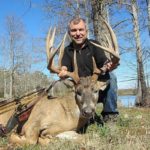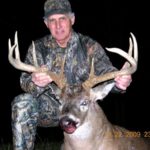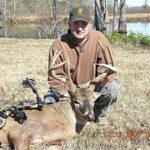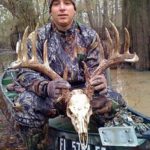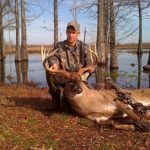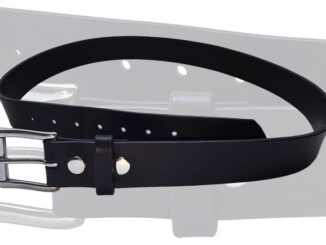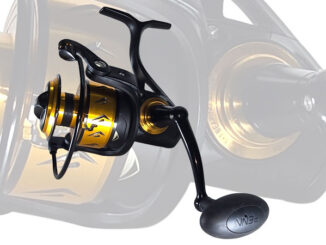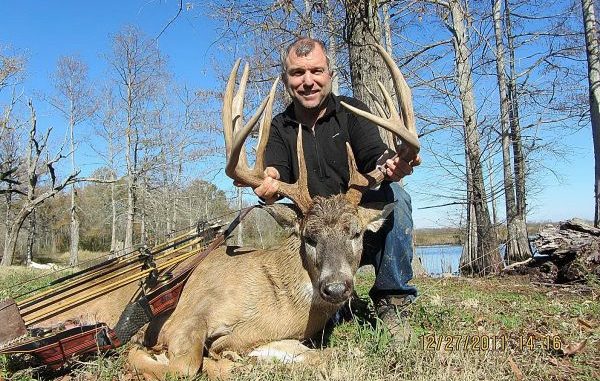
Deer hunting is quickly becoming as much about management as about shooting. Read on as Baton Rouge’s Roland Dugas describes his family’s approach to growing bucks.
Mark Huvall had seen a huge deer several times over the past few years, and now the buck was walking right into his lap.
“He walked up to within 6 yards of my blind,” Huvall said. “I released my arrow and watched him take off. I noticed that he staggered a couple of times as he ran so I felt I’d made a good shot.”
That the deer was a monster wasn’t in question, but what wasn’t clear until he recovered the animal was that it would stretch the tape to 200 inches.
And that kill wasn’t an accident — it was the product of years of strict management.
Any question of how management plays into the equation of hunting on the property is dispelled by walking into the camp of Roland Dugas and his family.
Most deer hunters’ mouths would reflexively drool like Pavlov’s dogs. Words can’t describe the beauty of the many 140- to 170- B&C bucks on the camp wall and in photos on the hard drive of Dugas’ laptop.
Admittedly, Dugas, at 49 years of age, has extensive experience professionally managing properties for commercial and recreational interests. He is also the past president of the South Louisiana Branch of the Quality Deer Management Association, as well as a current board member.
“We have always bought and sold recreational timberland,” said Dugas referring to his family that includes his 70-year-old father Roland Jr.; his brothers, 47-year-old Mark and 42-year-old André; and his 50-year-old brother-in-law Dave Kelly.
“My professional career is managing property, and between my brothers, dad and uncles we have learned quite a bit about successfully managing for white-tailed deer on various properties over the last 40 years,” The younger Roland Dugas said. “Whitetails are our passion, and we have been chasing them as bowhunters since 1972.
“We treat both hunting and managing the land as family outings.”
However, Dugas made one thing clear.
“I’m smart enough to realize we’re not wildlife biologists,” he said. “We’ve learned painstakingly over time. We’ve made mistakes, and we certainly don’t consider ourselves the best bowhunters out there.”
The family isn’t too proud to ask for help in making hte right decision for their property and deer herds.
“On our lands, over the years, we have relied upon whitetail biologists, waterfowl biologists and foresters to assist us professionally in developing these lands,” Dugas said. “There is also literature out there to assist any deer manager, such as that distributed by the QDMA as well as the books written by Louisiana biologist David Moreland.”
He said learning from others was the key to the Dugases’ development of management practices on their land.
“In the early days (1970s), we didn’t know really what a rub or scrape was,” Dugas admitted. “My two uncles, Richard Dugas and Stan Blouin, got a hold of a book — “In Pursuit of Trophy Whitetails” by Roger Rothhaar — and eventually (the author) came down to teach my two uncles.
“In that book, we learned so much about what a real scrape (by mature whitetails) was and what rubs really were. At that time (1972), there were not enough 5-year-old deer in Louisiana to exhibit the characteristics that most of the bucks Rothhaar was hunting in Ohio.”
That began to change as the elder members of the family prospered in their business ventures.
“And as the businesses of my father and uncles became more and more successful, we had the opportunity and ability to manage our own properties,” Dugas said.
That doesn’t mean a lot of money is required, however.
“Anybody can do it,” Dugas said. “It’s not just a rich man’s game.”
According to the die-hard bowhunter, the state of Louisiana has done quite well in managing for quality whitetails on many of its wildlife management areas.
“There’s been some fantastic deer to come out of these WMAs,” said the bowhunter.
Of course, habitat is one of the factors that dictate the caliber of deer possible from a given piece of property. And Dugas was adamant that Louisiana hardwood bottomlands provide the best habitat — and the parishes where the Mississippi, Red and Atchafalaya rivers come together are the cream of the crop.
“The Tensas area is the best place in the entire state in my opinion,” the bowhunter said.
